Taught by Tina May
When you google ‘SEO’ the majority of articles you’ll find are going to tell you things like “using the right keywords in your metadata” or “getting backlinks” and other forms of technical optimizations.
These things are important, but without first having a solid plan of keywords you want to target, you won’t be able to get the results you want.
When you do keyword research well, you can end up with a steady flow of not just traffic for the sake of website visitors, but also traffic that converts to leads or sales.
Before we touch on keyword research tools, it’s important to remember that as sophisticated as these tools are, they don’t know your business and your target customers. So they tend to be most effective once you already have a solid plan and are starting to grow your SEO effort rather than being a helpful starting place.
Keyword research is not just about thinking about which keywords you’re likely to rank for, but also which keywords are going to bring in your ideal target customer.
Let’s say you’re a luxury hotel, and after hours of researching potential keywords, you found out that writing a blog post on the “cheapest hotels in Bali” might be something that you could rank for and brings lots of traffic. However, it would’ve been unlikely for you to bring in sales anyway given you’re only looking for more high-end customers.
So when you’re planning for keyword research, you need to start with some of those foundational marketing concepts:
That way you’ll have an ideal customer persona in mind before you dive into keyword research.
The next step is to start brainstorming ideas for long-tail keywords that would help attract your ideal customer. Here you generally want to start with variations of your product or service. Let’s say you owned a restaurant in California, so you could be targeting keywords like:
That said, they’re probably going to be very hard to rank for since there is just so much competition for such general keywords. But when we narrow it down, we’re going to find keywords that are less competitive and easier to rank for, such as:
Not only are these keywords easier to rank for, but they also are more likely to attract our ideal target customer. But there isn’t any hard-and-fast rule for physical businesses on how location-specific they want to be. It depends on two things: how common your offering is; and where customers might be looking for you.
There are around 700 Italian restaurants in Los Angeles, so using a keyword like “italian restaurant los angeles” would’ve been hard to rank for. On the other hand, if you’re offering something rare like Ethiopian food, it’s probably quite easy to rank for since there are only 11 Ethiopian restaurants in LA. What’s more, when people don’t find good options in their immediate area, they are likely to expand the search anyway.
Despite the rabbit hole of the technical aspects of keyword research, a lot of it is just about getting into the hearts and minds of your target customer. We need to look for two things:
If you were to target the search term “gluten-free ethiopian restaurant in venice beach” you might be able to quickly get to the top result, but it would’ve been a waste anyway if nobody is searching for that.
Sticking with the restaurant example, beyond the description and the location, there are a few more specific keywords we want to target:
The key takeaway here is if you don’t really understand your customers - who they are, what they are looking for, and how they think - then you’re likely to waste your time with SEO. So, I always recommend understanding these brand foundations first.
One of the easiest ways to better understand your target customer is just to talk to them or to research what they discuss in these places:
To give you an example that’s not a physical business, I was working with a client releasing a keto cookbook. The first thing we did was to join every Facebook community we could find for weight loss methods, low-carb foods, and keto diets. We would spend weeks just listening and looking for what questions and concerns were coming up since many of those would also make for great SEO keywords.
Let’s think about some of the keywords a keto cookbook could look at targeting:
Some of these might still be too competitive, but the idea here is to think about anything your target audience might be searching for, even if it’s remotely related to your business.
You might notice that some are more targeted and have more buying intent than others. For example, someone searching for “easy keto recipes” might be more likely in the mood to buy than “how many carbs are there in an apple.” But if you’re the first person to create that content, it might drive lots of potential carb-conscious customers your way.
I remember reading a case study about a shoe company in the UK that sold products worldwide, and it fundamentally changed my perspective on SEO. One time they started having customers every day asking about how to convert UK to US shoe sizes, so they made a web page with a simple conversion table for customer’s reference. But at the time this wasn’t a very common thing to find online, so they quickly ranked number one on Google for ‘UK to US shoe size conversion.’ Their web traffic and sales spiked dramatically because it was bringing targeted traffic - people who were actively looking to buy new shoes.
I recommend that you go through this high-level brainstorming process first so that you already have some ideas in mind before diving into the SEO or keyword research tools.
The first thing I would do to test out keywords is to do a quick Google search for them. Let’s say we want to search “italian restaurant los angeles.”
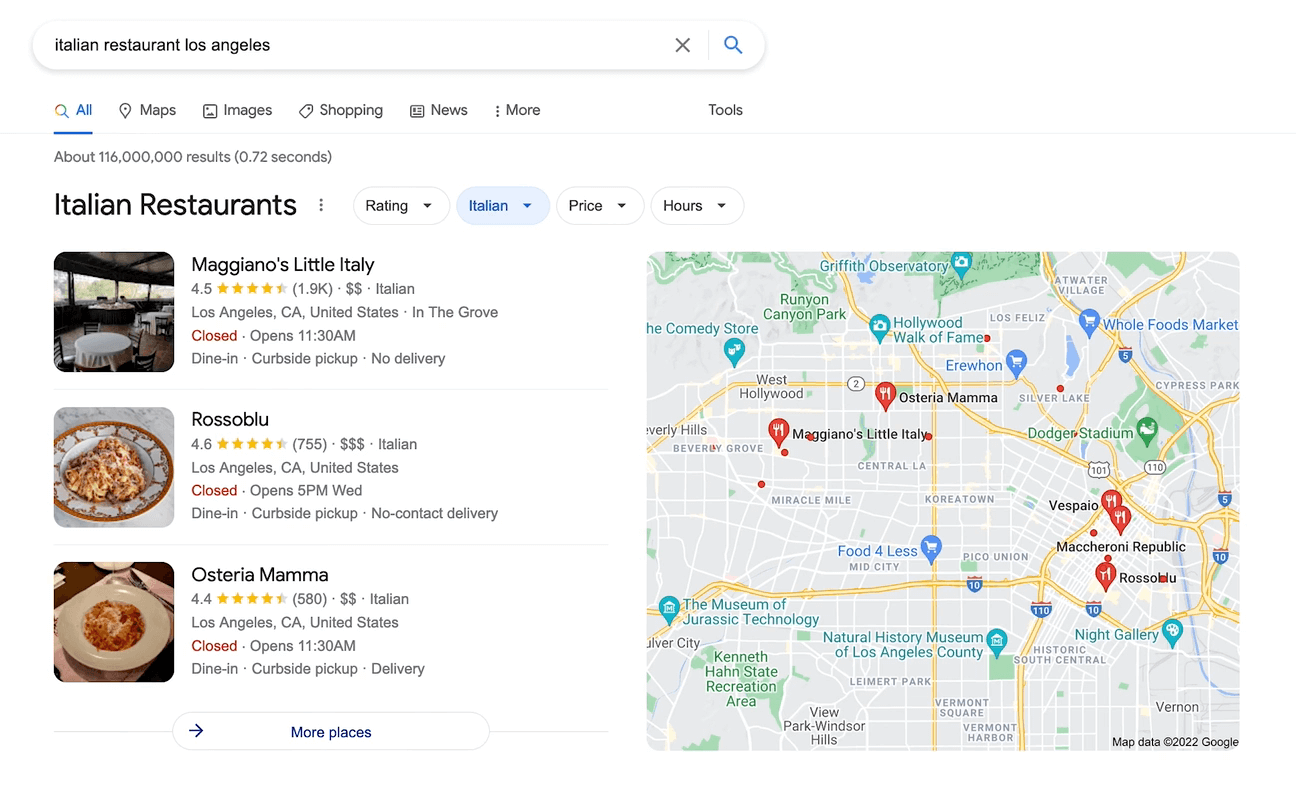
If you search and there aren’t many good articles out there, or you only see basic content from years ago, then that is a big opportunity to rank. On the other hand, if the exact topics you have in mind are showing high-quality content pages like the result below, then you need to dig a little further.
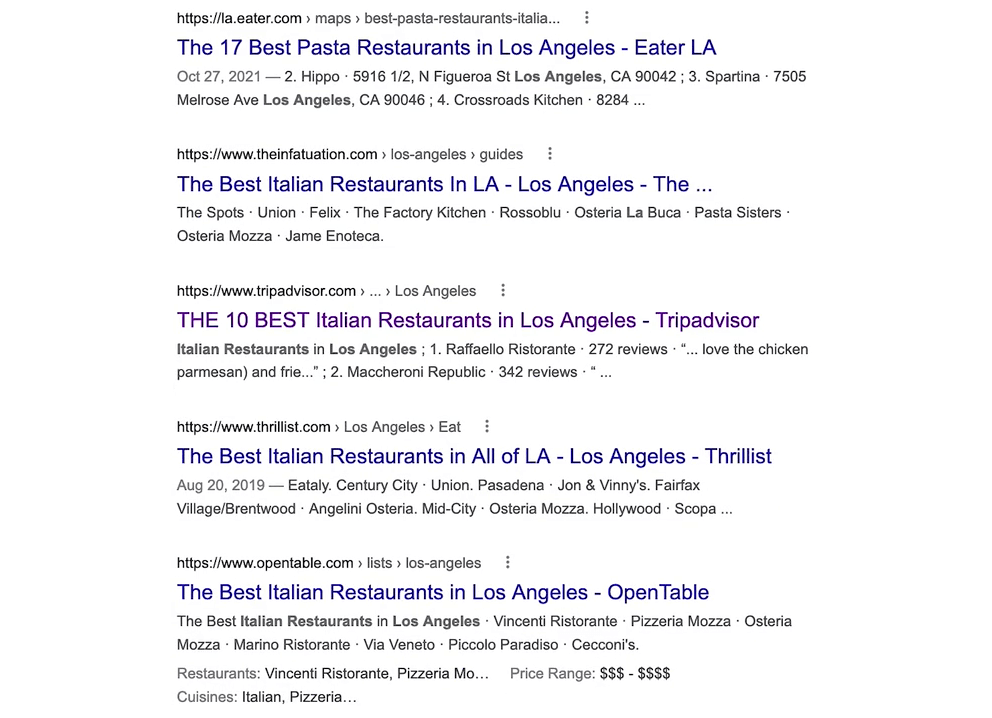
Let’s go one level more specific and look for “best gluten-free italian restaurant los angeles.”
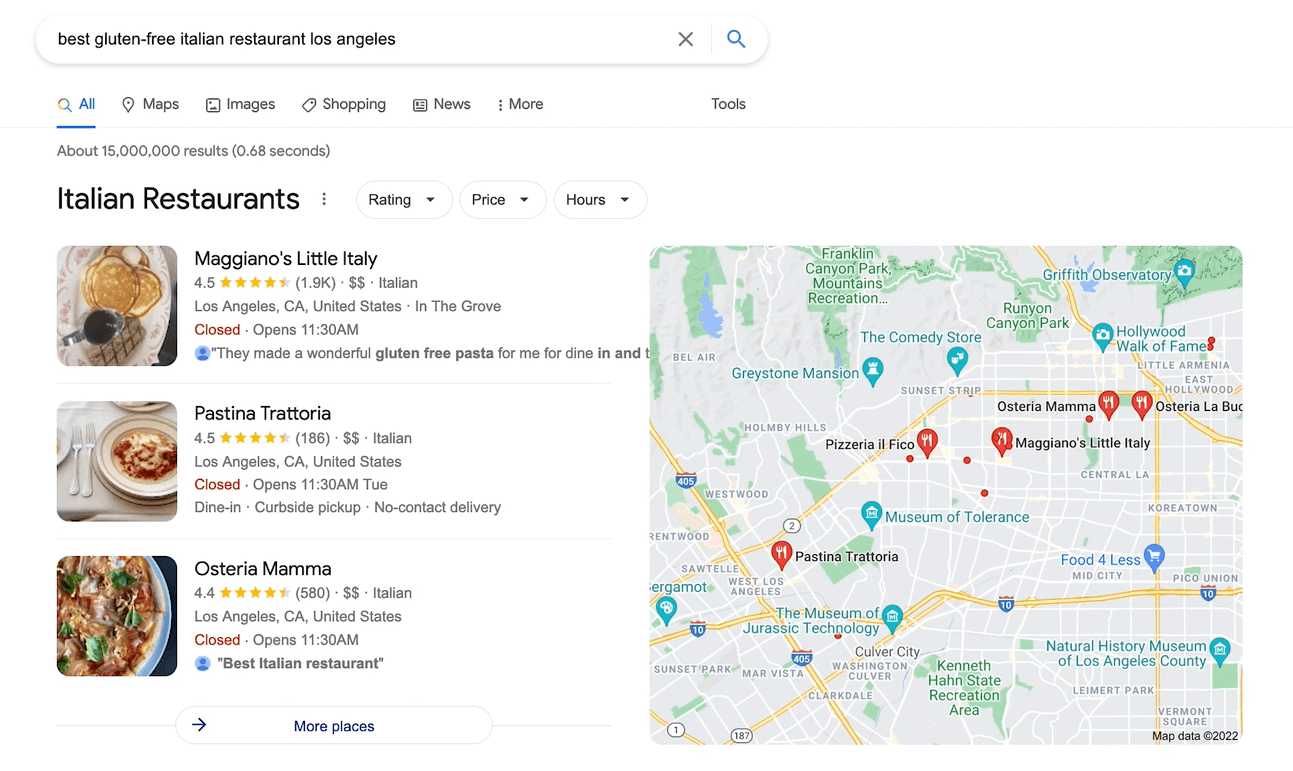
As we keep going down, we can see that most of these are still pretty specific and high-end. But a lot of them are not Italian, which signals that if I had an entire blog post dedicated to gluten-free Italian restaurants in LA, it’s likely to be more relevant than some of these other pages and allow us to capitalize on some of this traffic.
Tip: At the top of the search result, we have this featured section that changes depending on what you’re looking for. Sometimes you’ll find little snippets, recipes, maps, or a list of local businesses. We can see above that a particular place has ranked not necessarily from the name or the description itself, but from a review that a customer has left, saying that they had a wonderful gluten-free pasta for dine-in. So if you have a business, make sure you go out and ask your customers to write a review mentioning some of the things you would like to rank for SEO.
You can also use this to test your SEO for customers who already know about you and are looking specifically for your business. For example, “tina may coding school” or “10-day coding bootcamp in bali” or “joe’s coffee shop memphis” and see what you find. If people can’t even find you when they are actively searching for you, then it’s definitely the first place to start with your SEO strategy.
Ubersuggest has lots of different features and provides really helpful training videos and documentation if you want to dive deeper into it. There are 3 major features that I use the most here:
1. Traffic Overview
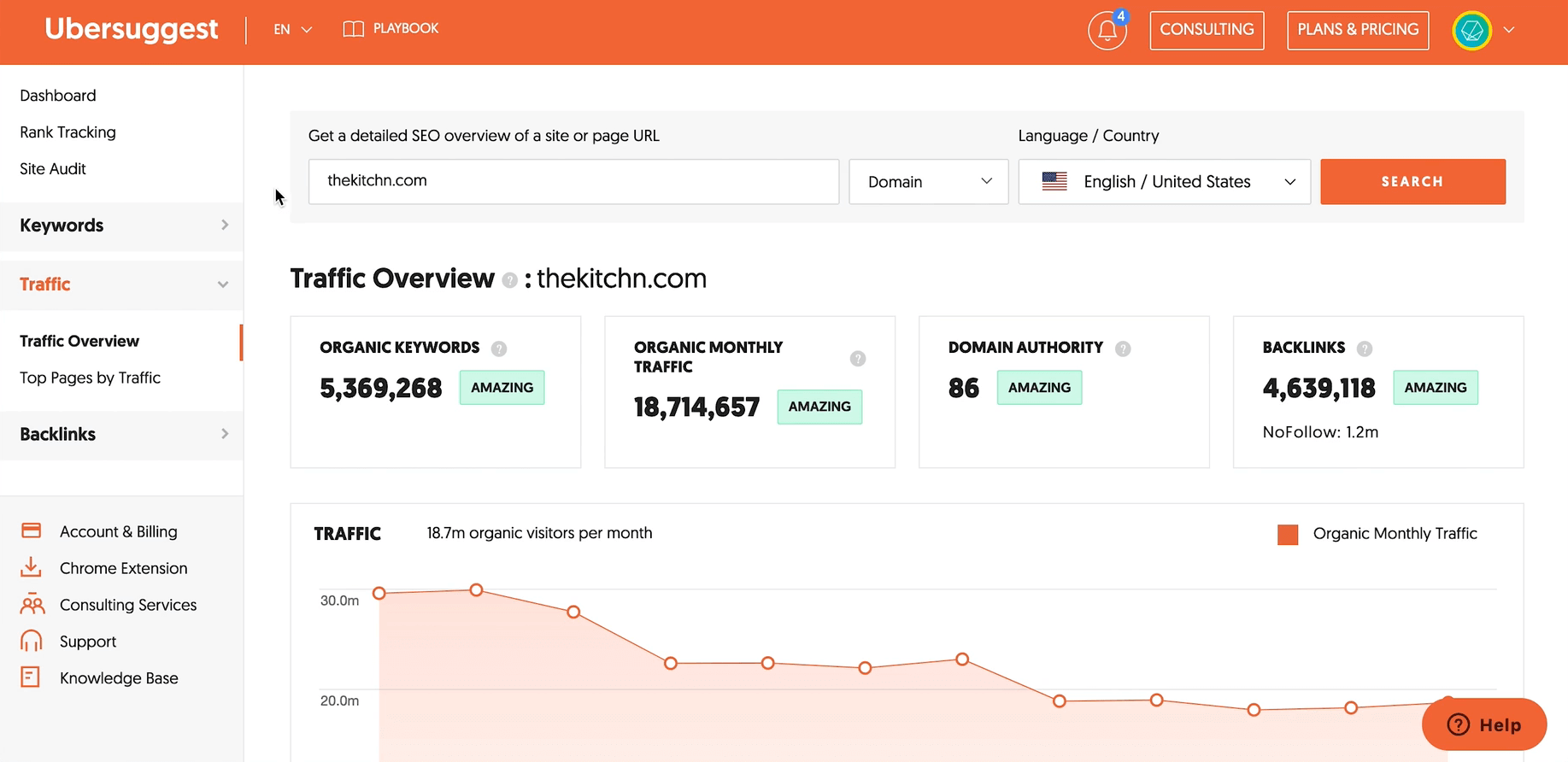
This is something that you can use to spy on the SEO of competitor pages and get the insights about which pages are ranking the highest. Importantly, when you choose a country and a language, the SEO results will be different from one to another.
Organic monthly traffic:
These numbers are not conclusive, but just an estimation. When it comes to organic traffic, nobody else outside of your analytics platform (i.e. Google Analytics or Plausible Analytics) is going to have really accurate data. But it tends to be a surprisingly accurate estimation at least for big businesses with big SEO strategies.
Domain Authority:
When it comes to domain authority (which we mentioned in a previous lesson), this is how good the reputation is based on Ubersuggest’s estimation, and not something that Google necessarily publishes for everyone.
Backlinks:
Thekitchn.com has 4.6 million times somebody links back to the website, which is a huge number and matters a lot in their effort to dominate the search result. But backlinks tend to be a more advanced strategy and require another field of expertise.
You can see that the number of backlinks also mentions NoFollow links beneath it. So whenever you create a link on the web, you can choose whether it’s a dofollow link (which is usually the default), or a nofollow link.
The dofollow link says to Google “I am recommending this site and this is a trustworthy resource.” And if your website has good SEO, you’re kind of passing along some of that SEO juice to them. On the other hand, nofollow links say to Google “I’m linking to this, but this is not a recommendation.”
Nofollow links are mostly required for any kind of paid advertising, such as influencer marketing or affiliate marketing, where they legally have to set a nofollow link to make sure that it’s genuine.
Traffic:
The website visitor trend on thekitchn.com seems to have dropped over time, but they’re not alone. I have noticed that almost every single platform I’ve looked at has also dropped from January 2021 to 2022. That may not necessarily mean they’ve all dropped, it may just mean that the capability of tracking has dropped due to lots of privacy regulations taking place all the time that impact how much traffic is tracked. So I would take this with a grain of salt.
2. Top Pages by Traffic:
Let’s dissect one of their most popular pages “How To Cook a Turkey: The Simplest, Easiest Method”
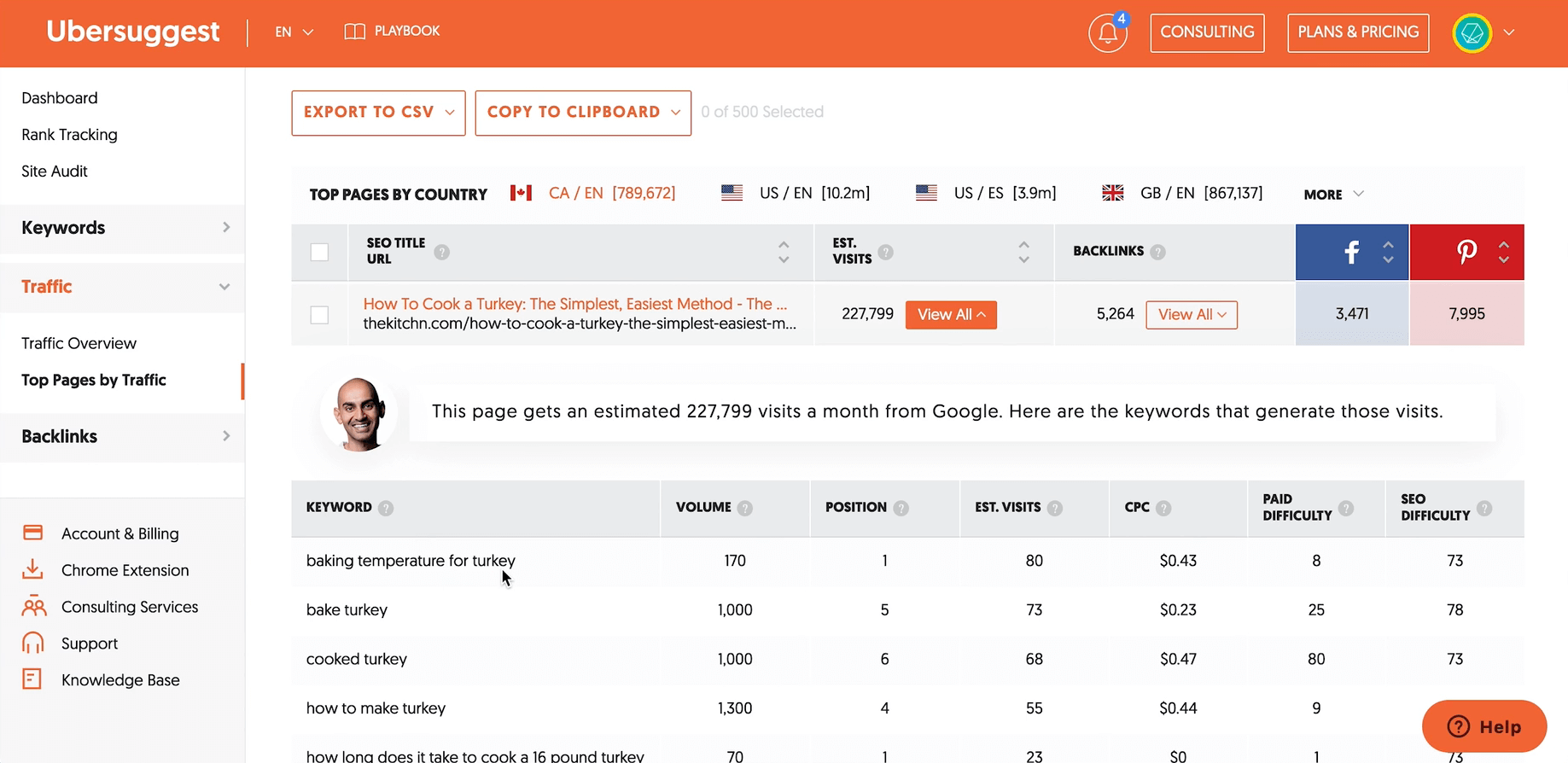
Let’s look at the list of the keywords that lead to this page. I mentioned before that we generally want to optimize each page of our website for only one set of keywords. However, that doesn’t mean that those are the only keywords people are going to find on your site, it’s more of a way of focusing your efforts and not trying to squeeze every possible idea into a single post.
It’s also worth keeping in mind that the ranking is based not just on the content of that page, but also on the reputation of the website. If you take the exact same blog post with the exact same code and pop it on your website, it’s not instantly going to be ahead of them. So if you’re fighting against bigger competitors, you’re going to have to be a bit more specific and a bit more focused than what they have.
3. Keywords overview
Let’s look at a keyword that I’ve researched for my past client - “keto recipe ideas.”
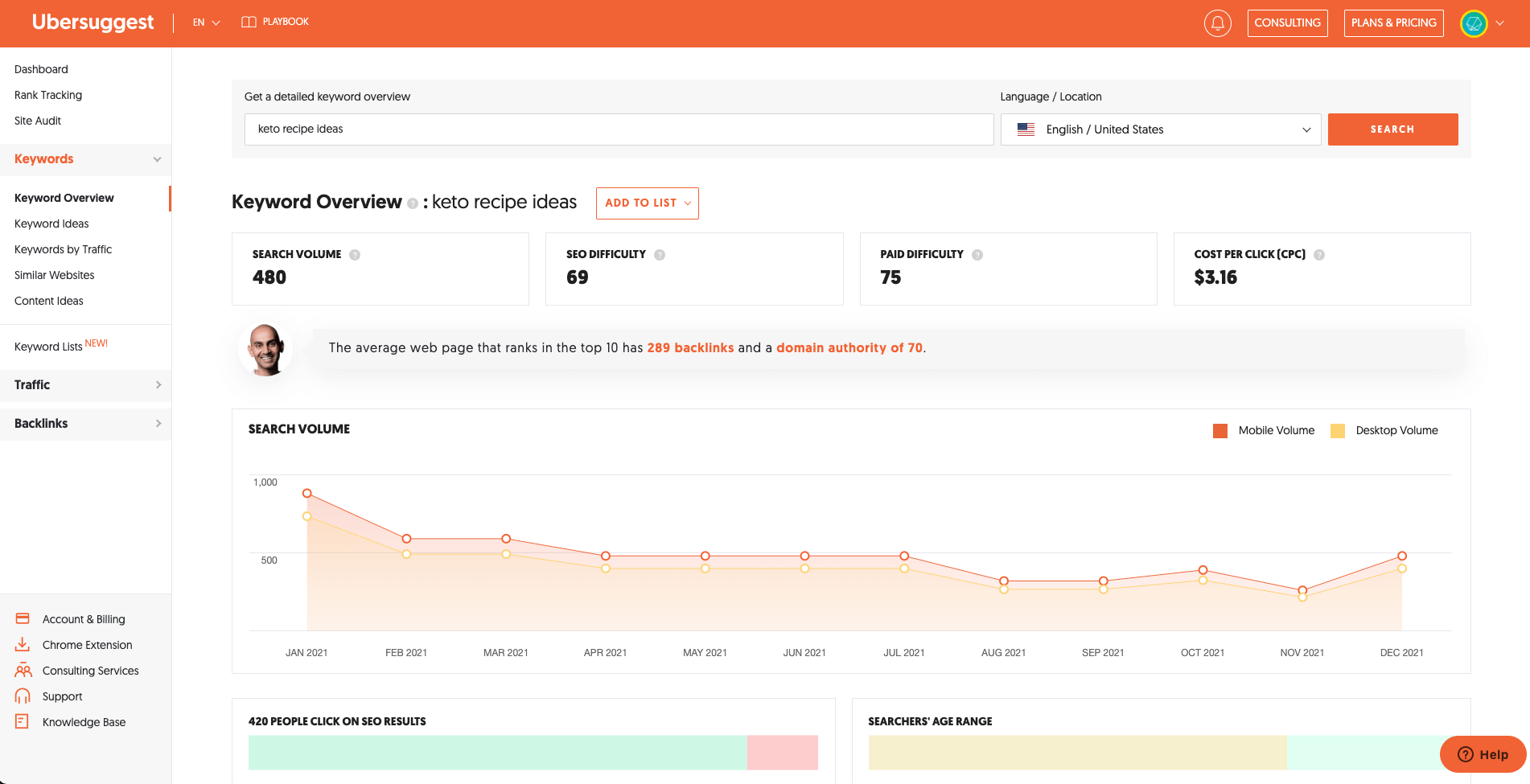
The app is estimating that only 480 people are searching for this per month, but I would say that is a dramatic underestimation of the overall potential. Remember that SEO is a compounding effort. If you have 20 people coming from a single search term, and then you create 10 blog posts with the same number of visitors, all of a sudden you’re getting 200 new people to your website per month. And if you’re publishing 10 blog posts per month, it starts to bring in a lot of traffic for your website over time.
I definitely recommend giving Ubersuggest a try, even just playing around and seeing what comes up. Importantly though, don’t get disheartened if the keywords you rank for (especially the long-tail ones) look like they have hardly any traffic because every number in this app needs to be taken with a grain of salt. If you genuinely think it’s going to drive a lot of traffic and you’re not investing a ton of time or money in creating that content, just give it a go and see what happens.
If you’re looking at competitor blogs for SEO inspiration…
Among the vast multitude of content marketing, SEO is just one of many techniques you might want to utilize to grow your web traffic. You have other types of content that are focused on virality where they have a high potential of being shared or clicked on social media. You also have articles that are more focused on Pinterest growth, and articles that are more about converting your existing audience and showcasing your products/services to get sales.
Looking at competitor content is helpful, but keep in mind that not every single page on someone’s website needs to be beaten on search results. Some of it has other purposes, so use it for inspiration only.
That’s a wrap on today’s lesson on the basics of keyword research. Good luck!